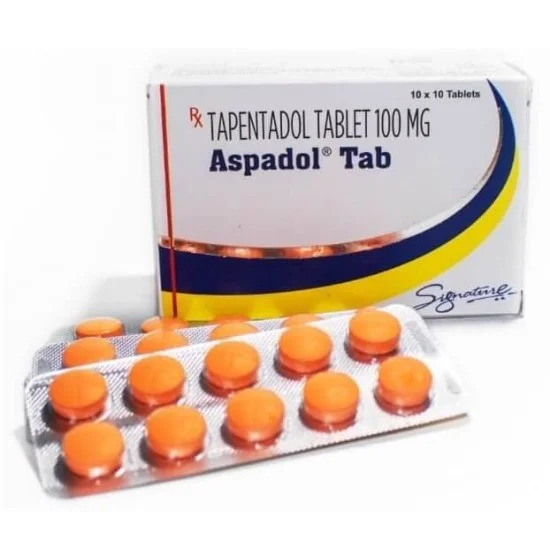Pain management is an essential aspect of healthcare, with numerous medications available to address varying levels and types of pain. Among these options, Aspadol (Tapentadol) has emerged as a distinctive choice, offering a dual-action mechanism to tackle moderate to severe pain effectively. In this blog, we’ll compare Aspadol with other common pain relief medications to highlight its unique features, advantages, and limitations.
Understanding Aspadol (Tapentadol)
Aspadol contains Tapentadol, an opioid analgesic that combines two mechanisms:
- Mu-Opioid Receptor Agonism (MOR):
- Blocks pain signals in the central nervous system.
- Norepinephrine Reuptake Inhibition (NRI):
- Enhances the body’s natural pain modulation system by increasing norepinephrine levels.
This dual mechanism makes Aspadol effective for both nociceptive pain (e.g., post-surgical or injury-related pain) and neuropathic pain (e.g., diabetic neuropathy).
Comparing Aspadol with Other Pain Relief Medications
Let’s examine how Aspadol stacks up against various pain relief options:
1. Aspadol vs. Traditional Opioids (e.g., Morphine, Oxycodone)
Mechanism of Action:
- Traditional opioids work primarily as mu-opioid receptor agonists, focusing solely on blocking pain signals in the CNS.
- Aspadol’s dual mechanism provides a broader approach by also addressing neuropathic pain.
Effectiveness:
- Aspadol is as effective as morphine and oxycodone for acute pain, with added benefits for neuropathic pain.
Side Effects:
- Both Aspadol and traditional opioids may cause drowsiness, nausea, and constipation.
- Aspadol is associated with fewer gastrointestinal side effects due to its balanced pharmacological profile.
Abuse Potential:
- While all opioids carry a risk of dependency, Aspadol’s norepinephrine reuptake inhibition may slightly reduce the abuse potential compared to traditional opioids.
2. Aspadol vs. NSAIDs (e.g., Ibuprofen, Naproxen)
Mechanism of Action:
- NSAIDs work by inhibiting cyclooxygenase (COX) enzymes, reducing inflammation and alleviating mild to moderate pain.
- Aspadol targets the CNS directly, making it more suitable for severe pain.
Effectiveness:
- NSAIDs are effective for inflammatory pain, such as arthritis or menstrual cramps, but are inadequate for severe pain or neuropathic pain.
- Aspadol’s dual mechanism addresses a wider range of pain conditions, including chronic and nerve-related pain.
Side Effects:
- NSAIDs can cause gastrointestinal issues (ulcers, bleeding) and kidney damage with prolonged use.
- Aspadol’s side effects are more CNS-related (drowsiness, dizziness) but pose less risk to the digestive system.
3. Aspadol vs. Acetaminophen (Paracetamol)
Mechanism of Action:
- Acetaminophen works centrally in the brain to reduce pain and fever, but its exact mechanism is not fully understood.
- Aspadol’s dual-action mechanism is more targeted and potent for severe pain.
Effectiveness:
- Acetaminophen is ideal for mild to moderate pain, such as headaches or minor injuries.
- Aspadol is more effective for conditions requiring strong pain management, such as post-operative pain or neuropathic disorders.
Side Effects:
- Acetaminophen is generally safe but can cause liver damage at high doses.
- Aspadol has a broader side effect profile but poses less risk to liver health.
4. Aspadol vs. Tramadol
Mechanism of Action:
- Both Aspadol and Tramadol act on mu-opioid receptors and inhibit norepinephrine reuptake.
- However, Aspadol is more potent and offers a faster onset of action.
Effectiveness:
- Tramadol is often used for moderate pain but may not be sufficient for severe pain.
- Aspadol’s enhanced action makes it more effective for severe and chronic pain conditions.
Side Effects:
- Tramadol’s metabolism can vary among individuals, leading to unpredictable effects.
- Aspadol provides more consistent pain relief with a similar side effect profile.
Abuse Potential:
- Both medications have a risk of dependency, but Aspadol’s balanced mechanism may offer a slight advantage in terms of misuse potential.
5. Aspadol vs. Gabapentin and Pregabalin
Mechanism of Action:
- Gabapentin and Pregabalin are anticonvulsants that target calcium channels to reduce neuropathic pain.
- Aspadol addresses both neuropathic and nociceptive pain through its dual mechanism.
Effectiveness:
- Gabapentin and Pregabalin are primarily effective for neuropathic pain but are not suitable for acute or severe nociceptive pain.
- Aspadol provides a broader spectrum of pain relief.
Side Effects:
- Gabapentinoids often cause sedation, dizziness, and weight gain.
- Aspadol’s side effects are more opioid-like but may be preferable for patients requiring multi-mechanism relief.
Choosing the Right Medication
The choice of pain relief medication depends on several factors:
- Type of Pain:
- Acute pain: Aspadol or traditional opioids.
- Neuropathic pain: Aspadol, Gabapentin, or Pregabalin.
- Inflammatory pain: NSAIDs.
- Severity of Pain:
- Mild to moderate pain: NSAIDs or Acetaminophen.
- Moderate to severe pain: Aspadol or Tramadol.
- Patient’s Medical History:
- Patients with gastrointestinal issues may prefer Aspadol over NSAIDs.
- Those with a history of opioid dependency should use all opioids cautiously, including Aspadol.
- Side Effect Tolerance:
- Consider individual tolerance to CNS effects or gastrointestinal complications when selecting a medication.
Conclusion
Aspadol stands out among pain relief medications due to its unique dual-action mechanism, offering effective relief for both nociceptive and neuropathic pain. Compared to traditional opioids, NSAIDs, or anticonvulsants, it provides a balanced approach to managing moderate to severe pain with fewer gastrointestinal side effects.
However, every medication has its pros and cons. Always consult a healthcare professional to determine the most suitable option based on your specific pain condition, medical history, and treatment goals. With informed choices, you can achieve optimal pain relief while minimizing risks.




